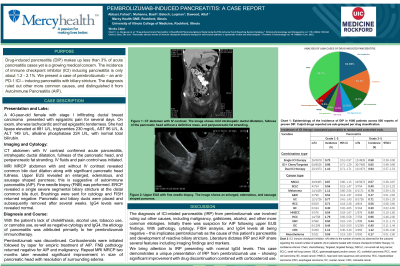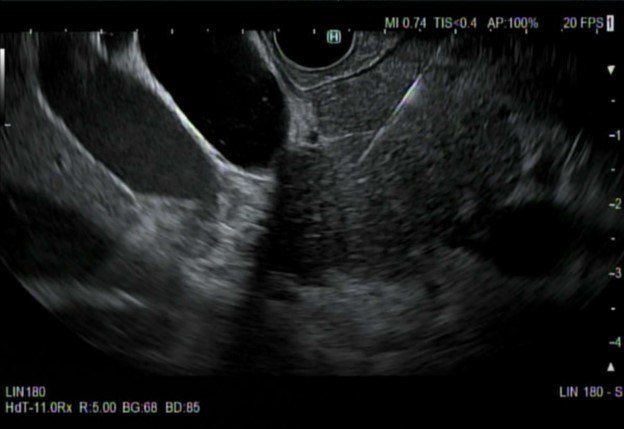Monday Poster Session
Category: Biliary/Pancreas
P1832 - Uncommon Culprit: Pancreatitis & Biliary Stricture Revealed
Monday, October 28, 2024
10:30 AM - 4:00 PM ET
Location: Exhibit Hall E

Has Audio

Abu Abbasi, MD
Mercy Health
Rockford, IL
Presenting Author(s)
Abu Fahad Abbasi, MD1, Luqman Baloch, MD1, Basil Muhanna, BSc2, Altaf Dawood, MD, MBBS1, Naser Khan, MD1
1Mercy Health, Rockford, IL; 2University of Illinois College of Medicine, Rockford, IL
Introduction: Drug-induced pancreatitis makes up less than 3% of all acute pancreatitis cases. We present a case of pembrolizumab-induced pancreatitis with biliary stricture due to immune checkpoint inhibitor (ICI) use.
Case Description/Methods: A 40-year-old female with stage I infiltrating ductal breast carcinoma presented with epigastric pain for several days. On exam she was tachycardic with epigastric tenderness. Lipase elevated to 881 U/L, triglycerides 230 mg/dL, AST 96 U/L, & ALT 149 U/L, alkaline phosphatase 224 U/L, with normal total bilirubin. CT abdomen with IV contrast confirmed acute pancreatitis, intrahepatic ductal dilatation, fullness of the pancreatic head, and peripancreatic fat stranding. IV fluids and pain control was initiated.
MRI MRCP abdomen with and without IV contrast revealed common bile duct dilation along with significant pancreatic head fullness. Upper EUS revealed an enlarged, edematous, and sausage-shaped pancreas – suggestive of autoimmune pancreatitis (AIP). Fine needle biopsy (FNB) was performed. ERCP revealed a single severe segmental biliary stricture at the distal common bile duct. Brushings were sent for cytology and FISH returned negative. Pancreatic and biliary ducts were placed and subsequently removed after several weeks. IgG4 levels returned normal. Patient was without alcohol use, cholelithiasis, tobacco use, or cannabis use. Etiology of pancreatitis was attributed to her pembrolizumab immunotherapy.
Pembrolizumab was discontinued. Corticosteroids were initiated followed by a taper for empiric treatment of AIP. FNB pathology returned negative for AIP and malignancy. Repeat MRI MRCP two months later revealed significant improvement in size of pancreatic head with resolution of surrounding edema.
Discussion: The diagnosis of ICI-related pancreatitis (IRP) from pembrolizumab use involved ruling out other causes including malignancy, gallstone, alcohol, and other more common etiologies. Initially there was suspicion for AIP following upper EUS findings. With pathology, cytology, FISH analysis, and IgG4 levels all being negative – this implicates pembrolizumab as the cause of this patient’s pancreatitis and development of reactive biliary stricture. Literature dictates IRP and AIP share several features including imaging findings and markers. We bring attention to IRP presenting with normal IgG4 levels. This case demonstrates a unique presentation of IRP from pembrolizumab use – showing significant improvement with drug discontinuation combined with corticosteroid use.

Disclosures:
Abu Fahad Abbasi, MD1, Luqman Baloch, MD1, Basil Muhanna, BSc2, Altaf Dawood, MD, MBBS1, Naser Khan, MD1. P1832 - Uncommon Culprit: Pancreatitis & Biliary Stricture Revealed, ACG 2024 Annual Scientific Meeting Abstracts. Philadelphia, PA: American College of Gastroenterology.
1Mercy Health, Rockford, IL; 2University of Illinois College of Medicine, Rockford, IL
Introduction: Drug-induced pancreatitis makes up less than 3% of all acute pancreatitis cases. We present a case of pembrolizumab-induced pancreatitis with biliary stricture due to immune checkpoint inhibitor (ICI) use.
Case Description/Methods: A 40-year-old female with stage I infiltrating ductal breast carcinoma presented with epigastric pain for several days. On exam she was tachycardic with epigastric tenderness. Lipase elevated to 881 U/L, triglycerides 230 mg/dL, AST 96 U/L, & ALT 149 U/L, alkaline phosphatase 224 U/L, with normal total bilirubin. CT abdomen with IV contrast confirmed acute pancreatitis, intrahepatic ductal dilatation, fullness of the pancreatic head, and peripancreatic fat stranding. IV fluids and pain control was initiated.
MRI MRCP abdomen with and without IV contrast revealed common bile duct dilation along with significant pancreatic head fullness. Upper EUS revealed an enlarged, edematous, and sausage-shaped pancreas – suggestive of autoimmune pancreatitis (AIP). Fine needle biopsy (FNB) was performed. ERCP revealed a single severe segmental biliary stricture at the distal common bile duct. Brushings were sent for cytology and FISH returned negative. Pancreatic and biliary ducts were placed and subsequently removed after several weeks. IgG4 levels returned normal. Patient was without alcohol use, cholelithiasis, tobacco use, or cannabis use. Etiology of pancreatitis was attributed to her pembrolizumab immunotherapy.
Pembrolizumab was discontinued. Corticosteroids were initiated followed by a taper for empiric treatment of AIP. FNB pathology returned negative for AIP and malignancy. Repeat MRI MRCP two months later revealed significant improvement in size of pancreatic head with resolution of surrounding edema.
Discussion: The diagnosis of ICI-related pancreatitis (IRP) from pembrolizumab use involved ruling out other causes including malignancy, gallstone, alcohol, and other more common etiologies. Initially there was suspicion for AIP following upper EUS findings. With pathology, cytology, FISH analysis, and IgG4 levels all being negative – this implicates pembrolizumab as the cause of this patient’s pancreatitis and development of reactive biliary stricture. Literature dictates IRP and AIP share several features including imaging findings and markers. We bring attention to IRP presenting with normal IgG4 levels. This case demonstrates a unique presentation of IRP from pembrolizumab use – showing significant improvement with drug discontinuation combined with corticosteroid use.

Figure: Upper EUS with FNB. The image shows an enlarged, edematous, and sausage-shaped pancreas.
Disclosures:
Abu Fahad Abbasi indicated no relevant financial relationships.
Luqman Baloch indicated no relevant financial relationships.
Basil Muhanna indicated no relevant financial relationships.
Altaf Dawood indicated no relevant financial relationships.
Naser Khan indicated no relevant financial relationships.
Abu Fahad Abbasi, MD1, Luqman Baloch, MD1, Basil Muhanna, BSc2, Altaf Dawood, MD, MBBS1, Naser Khan, MD1. P1832 - Uncommon Culprit: Pancreatitis & Biliary Stricture Revealed, ACG 2024 Annual Scientific Meeting Abstracts. Philadelphia, PA: American College of Gastroenterology.
